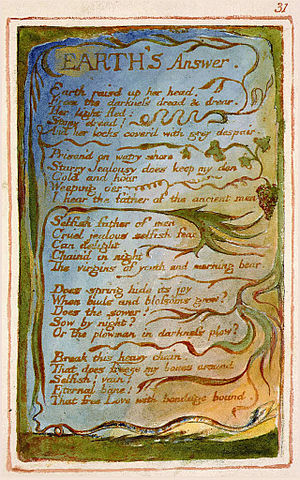August 27, 2021: Difference between revisions
From Gerald R. Lucas
m (Added templates.) |
m (Fixed templates.) |
||
| Line 44: | Line 44: | ||
{{Bib-Blake}} | {{Bib-Blake}} | ||
{{2021}} | {{2021}} | ||
Revision as of 08:28, 5 September 2021
|
Earth raised up her head |
Notes & Comentary
- ↑ From the Songs of Experience, 1794, which, along with “Introduction,” defines the “emotional conditions” of the poems in this book (Tomlinson 1987, p. 27). Here, the earth decries unnatural restrictions placed on the act of love by the “Selfish father of men,” and class on him to “Break this heavy chain” of moral bondage that perverts the natural world. The Earth further answers the call in “Introduction” for "the lapsèd soul” to turn back to God is also unjust.
- ↑ A reference to the God of the Old Testament, whom Blake considered tyrannical and jealous, always attempting to intimidate and control humanity. In Blake’s mythology, this god is named Urizen, characterized by reason and the imposer of moral bondage (see Tomlinson 1987, pp. 28, 47 and Greenblatt 2018, p. 55).
- ↑ See the last stanza of “Introduction.”
- ↑ Restrictions on love that morality imposes can corrupt that love, making it shameful (Tomlinson 1987, p. 28).
- ↑ I.e., all of life’s joys are perverted by unnatural restrictions placed on them.
Bibliography
- Ackroyd, Peter (1995). Blake: A Biography. New York: Ballantine Books.
- Battenhouse, Henry M. (1958). English Romantic Writers. New York: Barron’s Educational Series, Inc.
- Bloom, Harold (2003). William Blake. Bloom’s Major Poets. New York: Chelsea House.
- Frye, Northrup (1947). Fearful Symmetry: A Study of William Blake. Princeton, NJ: Princeton University Press.
- Gardner, Stanley (1969). Blake. Literary Critiques. New York: Arco.
- Green, Martin Burgess (1972). Cities of Light and Sons of Morning. Boston: Little, Brown.
- Greenblatt, Stephen, ed. (2018). The Norton Anthology of English Literature. The Major Authors. 2 (Tenth ed.). New York: W. W. Norton.
- Makdisi, Saree (2003). "The Political Aesthetic of Blake's Images". In Eaves, Morris. The Cambridge Companion to William Blake. Cambridge, UK: Cambridge UP. pp. 110–132.
- — (2015). Reading William Blake. Cambridge, UK: Cambridge University Press.
- Paulin, Tom (March 3, 2007). "The Invisible Worm". Guardian. Retrieved 2021-09-04.
- Thompson, E. P. (1993). Witness Against the Beast. New York: The New Press.
- Tomlinson, Alan (1987). Song of Innocence and of Experience by William Blake. MacMillan Master Guides. London: MacMillan Education.
- Wolfson, Susan J. (2003). "Blake's Language in Poetic Form". In Eaves, Morris. The Cambridge Companion to William Blake. Cambridge, UK: Cambridge UP. pp. 63–83.
Links and Web Resources
- Blake at the Internet Archive.
- Blake’s Notebook at the British Museum.
- William Blake Study Questions
